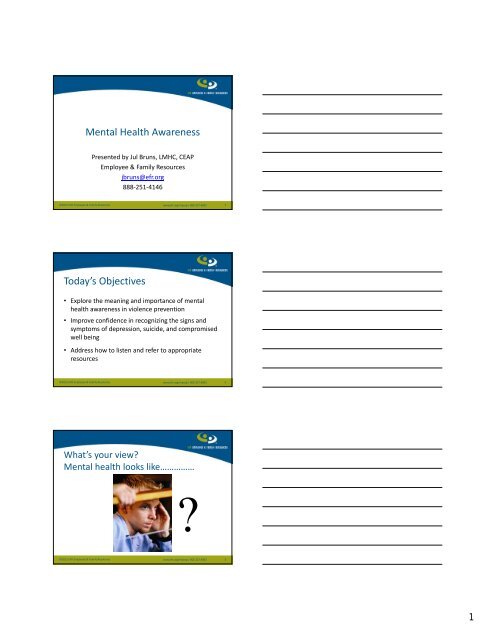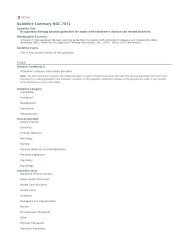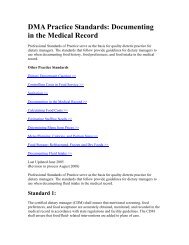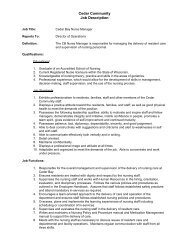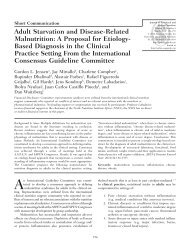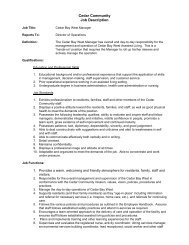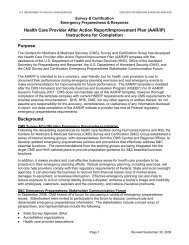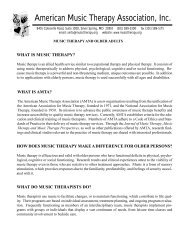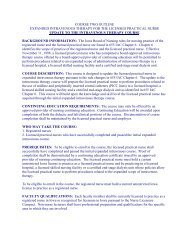Mental Health Awareness Today's Objectives
Mental Health Awareness Today's Objectives
Mental Health Awareness Today's Objectives
You also want an ePaper? Increase the reach of your titles
YUMPU automatically turns print PDFs into web optimized ePapers that Google loves.
<strong>Mental</strong> <strong>Health</strong> <strong>Awareness</strong>Presented by Jul Bruns, LMHC, CEAPEmployee & Family Resourcesjbruns@efr.org888‐251‐4146©2013 EFR Employee & Family Resources www.efr.org/myeap | 800.327.46921Today’s <strong>Objectives</strong>• Explore the meaning and importance of mentalhealth awareness in violence prevention• Improve confidence in recognizing the signs andsymptoms of depression, suicide, and compromisedwell being• Address how to listen and refer to appropriateresources©2013 EFR Employee & Family Resources www.efr.org/myeap | 800.327.46922What’s your view?<strong>Mental</strong> health looks like……………?©2013 EFR Employee & Family Resources www.efr.org/myeap | 800.327.469231
<strong>Mental</strong> <strong>Health</strong> <strong>Awareness</strong>• The ability to manage thoughts, feelings, andbehaviors• Thoughts, feelings, and actions are respectfuland appropriate to the situation• Stable mood and low reactivity©2013 EFR Employee & Family Resources www.efr.org/myeap | 800.327.46924It’s a Matter of Balance• Note changes in behavior: gradual over timeor suddenly• Changes in mood can create the seeds ofworkplace violence• Early recognition and intervention are key toviolence prevention©2013 EFR Employee & Family Resources www.efr.org/myeap | 800.327.46925It is Blues or Depression?• Am I just sad or am Idepressed?• Recent losses?• What’s the duration?• What’s the severity?• Functional impairment?• Unmet expectations?• Risk factors?©2013 EFR Employee & Family Resources www.efr.org/myeap | 800.327.469262
National Institute of <strong>Mental</strong> <strong>Health</strong>• Defines depression as “a complex conditionstemming from a variety of biological, social,emotional, and situational factors”• It’s neither ‘all in your head’ nor ‘all in yourgenes’• We’re moving beyond the “Bootstrap Theory”;not due to a personal weakness©2013 EFR Employee & Family Resources www.efr.org/myeap | 800.327.46927Symptoms of Depression• Sad, anxious, or “empty”mood• Loss of interest or pleasure• Weight gain or loss• Changes in sleep• Thoughts of death orsuicide• Restlessness, hostility• Extreme pessimism• Fatigue or low energy• Poor concentration orindecisiveness• Feelings of worthlessness orguilt• Hopelessness for the future• Isolation• Helplessness orpowerlessness©2013 EFR Employee & Family Resources www.efr.org/myeap | 800.327.46928Frequency of Symptoms• Experiencing 5 or more of these symptoms most days for twoweeks characterizes major depression; seek professionalassistance• Pervasive sadness with less than 5 symptoms may indicate amilder form of depression and still benefit fromintervention/treatment• Experiencing these symptoms makes everyday activitiesburdensome and not pleasurable• Sense of well being is compromised©2013 EFR Employee & Family Resources www.efr.org/myeap | 800.327.469293
What Causes Depression?• Complex combination of one or more of thefollowing:– Biological factors– Situational factors such as stress or loss– Cultural influences– Co‐existing illnesses– Personality factors– Coping styles– Thinking styles©2013 EFR Employee & Family Resources www.efr.org/myeap | 800.327.469210Things People Might Say……• “I don’t feel like myself anymore.”• Everything and everybody seems to bother me and Ican’t feel happy.”• “Everything I do takes so much effort.”• “All I want to do is sleep and be alone.”• “I feel achy and run down.”• “I get irritated and angry at the littlest things.”• “I feel like there is an incredible weight on me.”©2013 EFR Employee & Family Resources www.efr.org/myeap | 800.327.469211Early Intervention• What to do as a concerned person– Get information and help for yourself– Consult: don’t go it alone– Consider support versus enabling– Use active listening skills– Practice “I” statements– Normalize “getting stuck”, being in a temporarystate of unclear thinking©2013 EFR Employee & Family Resources www.efr.org/myeap | 800.327.4692124
Watch for Red Flags• Intimidating gestures• Verbal or physical threats ofharm• Erratic/unpredictablebehavior• Emotional instability/ moodswings• Suspicious or paranoidbehavior• Signs of severe stress ordepression• Significant changes inappearance/interactions• Bizarre or obsessivethoughts• Preoccupation withweapons and/or incidentsof violence©2013 EFR Employee & Family Resources www.efr.org/myeap | 800.327.469213Five Warning Signs ofEscalating Behavior1. Confusion2. Frustration3. Blame4. Anger5. Hostility©2013 EFR Employee & Family Resources www.efr.org/myeap | 800.327.469214Responses to Confusion1. Listen attentively tothe person2. Ask clarifyingquestions3. Give factualInformation©2013 EFR Employee & Family Resources www.efr.org/myeap | 800.327.4692155
Responses to Frustration1. Move the person to aquiet location2. Reassure them, talk ina clear voice3. Attempt to clarify theirconcerns©2013 EFR Employee & Family Resources www.efr.org/myeap | 800.327.469216Responses to Blame1. Draw the person back tothe facts2. Show respect andconcern3. Focus on areas ofagreement to helpresolve the situation©2013 EFR Employee & Family Resources www.efr.org/myeap | 800.327.469217Responses to Anger and Hostility1. Avoid argument2. Don’t offer solutions3. Isolate the person orevacuate area4. Contact your supervisorand security5. Be safe©2013 EFR Employee & Family Resources www.efr.org/myeap | 800.327.4692186
Defusing Skills• Detach: don’t take what they are saying personally• Use the person’s name when possible• Reflect ‐ reflect the hostile person’s feelings• Restate ‐ restate their concerns• Resolve ‐ initiate the process of resolving the problem• Do not attempt to negotiate with someone who verbally orphysically threatens you• If you sense any danger at all, leave the area immediately andcall security©2013 EFR Employee & Family Resources www.efr.org/myeap | 800.327.469219Facts about Suicide• Two‐thirds of people who complete suicide sufferfrom depressive illness• Depression is a treatable illness; people at risk needprofessional attention• Recent grief, anniversary of a loss, or a major lifeevent can be a risk factors• Failure, chronic unemployment, etc. can increase risk©2013 EFR Employee & Family Resources www.efr.org/myeap | 800.327.469220Suicide: Risk Factors• Impulsivity• Adverse life events; loss, a break up, failure• Family history of mental or substance abuse issues• Family history of suicide, violence, abuse• Prior suicide attempts• Access to firearms• Incarceration• Exposure to suicidal behavior of others, media©2013 EFR Employee & Family Resources www.efr.org/myeap | 800.327.4692217
Myths about Suicide• False: Asking someone about suicidal thoughts maytrigger the act• False: People who threaten suicide never go throughwith it• False: Suicide does not effect young people orelderly• False: Nothing can stop a person determined tocommit suicide• False: People who complete suicide don’t want help©2013 EFR Employee & Family Resources www.efr.org/myeap | 800.327.469222Suicide: Warning Signs• Threats of suicide – either direct or indirect• Verbal hints: “I won’t be around much longer” or“It’s hopeless”• Putting affairs in order (giving or throwing awayfavorite possessions)• Sudden cheerfulness after a period of depression• Hallucinations or bizarre thoughts©2013 EFR Employee & Family Resources www.efr.org/myeap | 800.327.469223Take Action• Recognize warning signs• Look for changes in personality, behavior, andhabits• Take all threats seriously• Don’t worry alone; consult• Be aware of available resources• Promote wellness©2013 EFR Employee & Family Resources www.efr.org/myeap | 800.327.4692248
Possible Barriers• Wishful thinking/denial: pretending aproblem doesn’t exist won’t make it go away• Lack of information and understanding aboutmental health• Thinking conditions are permanent and nottreatable• Not aware of available resources©2013 EFR Employee & Family Resources www.efr.org/myeap | 800.327.469225Be Proactive• Focus On: Behavior, performance, and earlyintervention: a win‐win for employee and employer• Promote <strong>Health</strong>y Behaviors: Encourage wellness,resources, consultations; use newsletters andpromotional material• Identify Resources: Consult trusted professionals,know your community resources, EAP, ask questions,review situations, be prepared©2013 EFR Employee & Family Resources www.efr.org/myeap | 800.327.469226Resources• http://www.nimh.nih.gov• http://www.nim.nih.gov/medlineplus• National Suicide Lifeline: 1‐800‐273‐TALK (1‐800‐273‐8255)• The Relaxation & Stress Reduction Workbook: Davis, Eshelman & McKay• The Depression Workbook: Copeland & Mckay• The Resiliency Factor: Karen Reivich & Andrew Shatte• The Resiliency Advantage: Al Siebert• Dancing in the Dark: How to Take Care of Yourself When Someone YouLove is Depressed: Bernadette Stankard and Amy Viets©2013 EFR Employee & Family Resources www.efr.org/myeap | 800.327.4692279
Wrap‐Up and QuestionsThank you!©2013 EFR Employee & Family Resources www.efr.org/myeap | 800.327.46922810


